.gif)
Square one (puzzle)
Encyclopedia
The Square One, also known as Back to Square One and Cube 21, is a puzzle similar to the Rubik's Cube
. Its distinguishing feature among the numerous Rubik's Cube variants is that it can change shape as it is twisted, due to the way it is cut, thus adding an extra level of challenge and difficulty. A Super Square One puzzle was recently introduced, which has two additional layers that can be scrambled and solved independently of the rest of the puzzle.

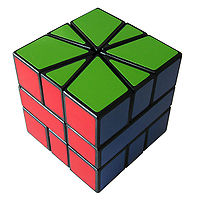
and triangular
pieces. They are also called corner
and edge
pieces, respectively. There are all together 8 kite and 8 triangular pieces. The kite pieces are 60 degrees wide, while the triangular pieces are 30 degrees wide, relative to the center of the layer.
The middle layer contains two trapezoid
pieces, which together may form an irregular hexagon or a square
.
Each layer can be rotated freely, and if the boundaries of pieces in all layers line up, the puzzle can be twisted vertically, interchanging half of the top layer with half of the bottom. In this way, the pieces of the puzzle can be scrambled. Note that because the kite pieces are precisely twice the angular width of the triangular pieces, the two can be freely intermixed, with two triangular pieces taking the place of a single kite piece and vice versa. This leads to bizarre shape changes within the puzzle at any point.
For the puzzle to be in cube shape, the upper and lower layers must have alternating kite and triangular pieces, with 4 kite and 4 triangular pieces on each layer, and the middle layer must have a square shape. However, since only two shapes are possible for the middle layer, there is a quick sequence of twists which changes the shape of the middle layer from one to the other without touching the rest of the puzzle.
Once the puzzle has a cube shape, the upper and lower layers are cut in an Iron Cross
-like fashion, or equivalently cut by two concentric
(standard) crosses
, that make an angle with each other.
Like Rubik's Cube, the pieces are coloured. For the puzzle to be solved, not only does it need to be in cube shape, but each face of the cube must also have a uniform colour. In its solved (or original) state, viewing the cube from the face with the word "Square-1" printed on it, the colours are: white on top, green on the bottom, yellow in front, red on the left, orange on the right, and blue behind. Alternative versions of the Square One may have different colour schemes.
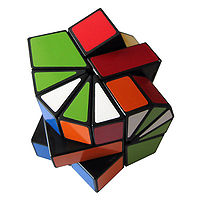
The majority of solutions provide a large set of algorithms. These are sequences of turns and twists that will rearrange a small number of pieces while leaving the rest of the puzzle untouched. Examples include swapping two pieces, cycling through three pieces, etc. Larger scale algorithms are also possible, such as interchanging the top and bottom layers. Through the systematic use of these algorithms, the puzzle is gradually solved.
Like solutions of the Rubik's Cube, the solutions of Square One depend on the use of algorithms discovered either by trial and error, or by using computer searches. However, while solutions of Rubik's Cube rely on these algorithms more towards the end, they are heavily used throughout the course of solving the Square One. This is because the uniform shape of the pieces in the Rubik's cube allows one to focus on positioning a small subset of pieces while disregarding the rest, at least at the beginning of a solution. However, with the Square One, the free intermixing of corner and edge pieces can sometimes cause a certain desired operation to be physically blocked; so one must take all pieces into account right from the beginning. Some solutions of the Square One rely solely on the use of algorithms.
If both rotations and reflections are counted once only, the number of positions reduces to 15! ÷ 3 = 435,891,456,000. Also, it always can be solved in a maximum of 14 moves.
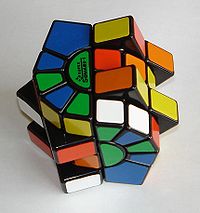
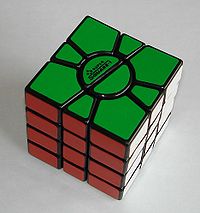
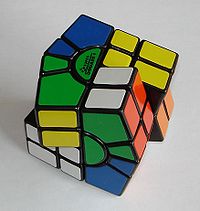 The Super Square One is a 4-layer version of the Square One. Just like the Square One, it can adopt non-cubic shapes as it is twisted. As of 2009, it is sold by Uwe Mèffert
The Super Square One is a 4-layer version of the Square One. Just like the Square One, it can adopt non-cubic shapes as it is twisted. As of 2009, it is sold by Uwe Mèffert
in his puzzle shop, Meffert's.
It consists of 4 layers of 8 pieces, each surrounding a circular column which can be rotated along a perpendicular axis. This allows the pieces from the top and bottom layers and the middle two layers to be interchanged. Each layer consists of 8 movable pieces: 4 wider wedges and 4 narrower wedges. In the top and bottom layers, the wider pieces are the "corner" pieces, and the narrower pieces are the "edge pieces". In the middle two layers, the wider pieces are the "edge" pieces, and the narrower pieces are the "face centers". The wider pieces are exactly twice the angular width of the narrower pieces, so that two narrower pieces can fit in the place of one wider piece. Thus, they can be freely intermixed. This leads to the puzzle adopting a large variety of non-cubic shapes.
Rubik's Cube
Rubik's Cube is a 3-D mechanical puzzle invented in 1974 by Hungarian sculptor and professor of architecture Ernő Rubik.Originally called the "Magic Cube", the puzzle was licensed by Rubik to be sold by Ideal Toy Corp. in 1980 and won the German Game of the Year special award for Best Puzzle that...
. Its distinguishing feature among the numerous Rubik's Cube variants is that it can change shape as it is twisted, due to the way it is cut, thus adding an extra level of challenge and difficulty. A Super Square One puzzle was recently introduced, which has two additional layers that can be scrambled and solved independently of the rest of the puzzle.


History
The Square One, with the full name "Back to Square One", and alternative name "Cube 21", was invented by Karel Hršel and Vojtěch Kopský around 1990. Application for Czechoslovak patent was filed on 8 November 1990, the patent was approved on 26 October 1992 with patent number CS 277266 B6. On March 16, 1993, it was patented in the USA with patent number US5,193,809.http://patft.uspto.gov/netacgi/nph-Parser?u=/netahtml/srchnum.htm&Sect1=PTO1&Sect2=HITOFF&p=1&r=1&l=50&f=G&d=PALL&s1=5193809.WKU.&OS=PN/5193809&RS=PN/5193809 Its design was also patented on October 5, 1993, with patent number D340,093.Description
The Square One consists of three layers. The upper and lower layers contain kiteKite (geometry)
In Euclidean geometry a kite is a quadrilateral whose four sides can be grouped into two pairs of equal-length sides that are next to each other. In contrast, a parallelogram also has two pairs of equal-length sides, but they are opposite each other rather than next to each other...
and triangular
Triangle
A triangle is one of the basic shapes of geometry: a polygon with three corners or vertices and three sides or edges which are line segments. A triangle with vertices A, B, and C is denoted ....
pieces. They are also called corner
Corner
A corner is the place where two lines meet at an angle, and a concave corner of intersecting walls is generally thought to be the least beneficial position to be in a life-or-death situation. From this notion was born the verb to corner, which is used to mean "to back into a corner" and usually...
and edge
Edge (geometry)
In geometry, an edge is a one-dimensional line segment joining two adjacent zero-dimensional vertices in a polygon. Thus applied, an edge is a connector for a one-dimensional line segment and two zero-dimensional objects....
pieces, respectively. There are all together 8 kite and 8 triangular pieces. The kite pieces are 60 degrees wide, while the triangular pieces are 30 degrees wide, relative to the center of the layer.
The middle layer contains two trapezoid
Trapezoid
In Euclidean geometry, a convex quadrilateral with one pair of parallel sides is referred to as a trapezoid in American English and as a trapezium in English outside North America. A trapezoid with vertices ABCD is denoted...
pieces, which together may form an irregular hexagon or a square
Square (geometry)
In geometry, a square is a regular quadrilateral. This means that it has four equal sides and four equal angles...
.
Each layer can be rotated freely, and if the boundaries of pieces in all layers line up, the puzzle can be twisted vertically, interchanging half of the top layer with half of the bottom. In this way, the pieces of the puzzle can be scrambled. Note that because the kite pieces are precisely twice the angular width of the triangular pieces, the two can be freely intermixed, with two triangular pieces taking the place of a single kite piece and vice versa. This leads to bizarre shape changes within the puzzle at any point.
For the puzzle to be in cube shape, the upper and lower layers must have alternating kite and triangular pieces, with 4 kite and 4 triangular pieces on each layer, and the middle layer must have a square shape. However, since only two shapes are possible for the middle layer, there is a quick sequence of twists which changes the shape of the middle layer from one to the other without touching the rest of the puzzle.
Once the puzzle has a cube shape, the upper and lower layers are cut in an Iron Cross
Iron Cross
The Iron Cross is a cross symbol typically in black with a white or silver outline that originated after 1219 when the Kingdom of Jerusalem granted the Teutonic Order the right to combine the Teutonic Black Cross placed above a silver Cross of Jerusalem....
-like fashion, or equivalently cut by two concentric
Concentric
Concentric objects share the same center, axis or origin with one inside the other. Circles, tubes, cylindrical shafts, disks, and spheres may be concentric to one another...
(standard) crosses
Crosses
Crosses may refer to:* Cross, the symbol* Crosses , the fourth album for the Belgian rock band Zornik* Crosses, Cher, a French municipality* Crosses, a musical project featuring members of Deftones and Far...
, that make an angle with each other.
Like Rubik's Cube, the pieces are coloured. For the puzzle to be solved, not only does it need to be in cube shape, but each face of the cube must also have a uniform colour. In its solved (or original) state, viewing the cube from the face with the word "Square-1" printed on it, the colours are: white on top, green on the bottom, yellow in front, red on the left, orange on the right, and blue behind. Alternative versions of the Square One may have different colour schemes.

Solutions
A good number of solutions for this puzzle exist on the internet. Some solutions employ the classical layer-by-layer method, while other approaches include putting the corner pieces in place first, then the edge pieces, or vice versa. Some solutions are a combination of these approaches. Although these solutions use different approaches, most of them try to restore the cube shape of the puzzle first, regardless of the placement of the pieces and the parity of the middle layer, and then proceed to put the pieces in their correct places while preserving the cube shape.The majority of solutions provide a large set of algorithms. These are sequences of turns and twists that will rearrange a small number of pieces while leaving the rest of the puzzle untouched. Examples include swapping two pieces, cycling through three pieces, etc. Larger scale algorithms are also possible, such as interchanging the top and bottom layers. Through the systematic use of these algorithms, the puzzle is gradually solved.
Like solutions of the Rubik's Cube, the solutions of Square One depend on the use of algorithms discovered either by trial and error, or by using computer searches. However, while solutions of Rubik's Cube rely on these algorithms more towards the end, they are heavily used throughout the course of solving the Square One. This is because the uniform shape of the pieces in the Rubik's cube allows one to focus on positioning a small subset of pieces while disregarding the rest, at least at the beginning of a solution. However, with the Square One, the free intermixing of corner and edge pieces can sometimes cause a certain desired operation to be physically blocked; so one must take all pieces into account right from the beginning. Some solutions of the Square One rely solely on the use of algorithms.
Number of positions
If different rotations of a given permutation are counted only once while reflections are counted individually, there are 170 × 2 × 8! × 8! = 552,738,816,000 positions.If both rotations and reflections are counted once only, the number of positions reduces to 15! ÷ 3 = 435,891,456,000. Also, it always can be solved in a maximum of 14 moves.
Records
Bingliang Li of China holds the world record single (8.65 seconds, set at the Guangdong Open 2010) and average (11.78 seconds, set at Shenzhen University 2011) for the Square-1.Super Square One



Uwe Mèffert
Uwe Mèffert has manufactured and sold mechanical puzzles in the style of Rubik's Cube since the original Cube craze. His first design was the Pyraminx and others include the Megaminx, Skewb and Skewb Diamond...
in his puzzle shop, Meffert's.
It consists of 4 layers of 8 pieces, each surrounding a circular column which can be rotated along a perpendicular axis. This allows the pieces from the top and bottom layers and the middle two layers to be interchanged. Each layer consists of 8 movable pieces: 4 wider wedges and 4 narrower wedges. In the top and bottom layers, the wider pieces are the "corner" pieces, and the narrower pieces are the "edge pieces". In the middle two layers, the wider pieces are the "edge" pieces, and the narrower pieces are the "face centers". The wider pieces are exactly twice the angular width of the narrower pieces, so that two narrower pieces can fit in the place of one wider piece. Thus, they can be freely intermixed. This leads to the puzzle adopting a large variety of non-cubic shapes.
Solution
Despite its appearance, the Super Square One is not significantly more difficult to solve than the original Square One. The middle layers are nearly identical to the top and bottom layers of the Square One, and may be solved independently using the same methods as the Square One. The corners of the middle layers are distinguishable because the corners with the same two colors are mirror images of each other, but the middle edges of each face are interchangeable since they show only one color each.External links
- The Square One patent
- The design patent
- Original Czechoslovak patent (PDF)
- (Back to) Square One / Cube 21 (With a program to solve Square one)
- Play the Square 1 online
- http://www.ganpuzzle.com/square1.htm Learn to Solve Square-1 with step by step animation accompanied by detailed descriptions.

